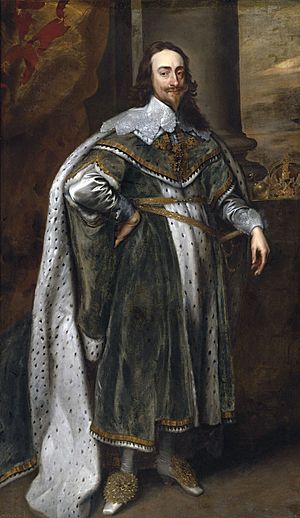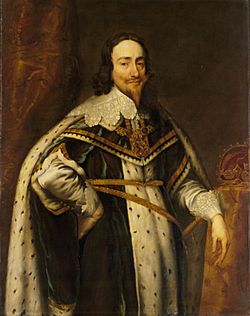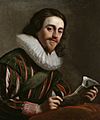Charles I of England facts for kids
Quick facts for kids Charles I |
|
|---|---|

Portrait from the studio of Anthony van Dyck, 1636
|
|
| King of England and Ireland (more...) | |
| Reign | 27 March 1625 – 30 January 1649 |
| Coronation | 2 February 1626 |
| Predecessor | James I |
| Successor |
|
| King of Scotland (more...) | |
| Reign | 27 March 1625 – 30 January 1649 |
| Coronation | 18 June 1633 |
| Predecessor | James VI |
| Successor | Charles II |
| Born | 19 November 1600 Dunfermline Palace, Dunfermline, Scotland |
| Died | 30 January 1649 (aged 48) Whitehall, London, England |
| Cause of death | Execution |
| Burial | 9 February 1649 St George's Chapel, Windsor Castle, England |
| Spouse | |
| Issue more... |
|
| House | Stuart |
| Father | James VI and I |
| Mother | Anne of Denmark |
| Religion | Anglican |
Charles I (19 November 1600 – 30 January 1649) was King of England, Scotland, and Ireland from 27 March 1625 until his execution in 1649. He was born into the House of Stuart as the second son of King James VI of Scotland, but after his father inherited the English throne in 1603 (as James I), he moved to England, where he spent much of the rest of his life. He became heir apparent to the kingdoms of England, Scotland, and Ireland in 1612 upon the death of his elder brother, Henry Frederick, Prince of Wales. An unsuccessful and unpopular attempt to marry him to the Spanish Habsburg princess Maria Anna culminated in an eight-month visit to Spain in 1623 that demonstrated the marriage negotiations' futility. Two years later, he married the Bourbon princess Henrietta Maria of France.
After his succession in 1625, Charles quarrelled with the Parliament of England, which sought to curb his royal prerogative. He believed in the divine right of kings, and was determined to govern according to his own conscience. Many of his subjects opposed his policies, in particular the levying of taxes without parliamentary consent, and perceived his actions as those of a tyrannical absolute monarch. His religious policies, coupled with his marriage to a Roman Catholic, generated antipathy and mistrust from Reformed religious groups such as the English Puritans and Scottish Covenanters, who thought his views too Catholic. He supported high church Anglican ecclesiastics such as Richard Montagu and William Laud, and failed to aid continental Protestant forces successfully during the Thirty Years' War. His attempts to force the Church of Scotland to adopt high Anglican practices led to the Bishops' Wars, strengthened the position of the English and Scottish parliaments, and helped precipitate his own downfall.
From 1642, Charles fought the armies of the English and Scottish parliaments in the English Civil War. After his defeat in 1645, he surrendered to a Scottish force that eventually handed him over to the English Parliament (the "Long Parliament"). Charles refused to accept his captors' demands for a constitutional monarchy, and temporarily escaped captivity in November 1647. Re-imprisoned on the Isle of Wight, he forged an alliance with Scotland, but by the end of 1648 the Parliamentarian New Model Army had consolidated its control over England. Charles was tried, convicted, and executed for high treason in January 1649. The monarchy was abolished and the Commonwealth of England was established as a republic. The monarchy was restored to Charles's son, Charles II, in 1660.
Early life
Charles was born at Fife, Scotland, before his father came to the throne of England. He had an elder brother, Henry, who was clever, handsome and popular, and who was next in line for the throne. Henry died suddenly in 1612, and his brother Charles was made Prince of Wales in his place, showing that he was now the heir to the throne. Charles was less suited to be king than Henry had been, because he was small and weak and not as clever. After his brother died, the person he was closest to was George Villiers, Duke of Buckingham, who was also his father's best friend. The Duke of Buckingham was very powerful and rich, but was not popular with common people. He took Charles to Spain in the hope of finding him a Spanish princess as a bride, but they had a lot of problems on the journey and could not persuade the Spanish king to give them his daughter as a wife for Charles. On the way home, they went to France, and there Charles met the French royal family. The youngest of the French princesses was called Henrietta Maria of France, and Charles later chose her to be his wife.
King of England
When Charles became king, he needed money for a war with Spain, but Parliament wouldn't give it to him. Therefore, he dissolved parliament and did not call it again for eleven years, from 1629 to 1640. This made him very unpopular with the people, who did not like the different taxes they had to pay directly to the king, since Parliament could not vote to give him any budget. Many also did not like the King's closest adviser, William Laud, Archbishop of Canterbury, who was trying to force everyone in England to use the same Anglican Prayer Book and stop the many other Protestant denominations that were becoming popular at that time.
When the king and the Archbishop then tried to force a Prayer Book on Scotland, which was even more Protestant (Calvinist), armed rebellion broke out there. Now that the king was at war, he needed more money than ever, so he had no choice but to call Parliament again in 1640. The members of Parliament, angry at the things that had been going on for 11 years, did not want to give him money to fight his war, instead, they spent the session complaining about what had been going on in the country for the last 11 years. So after only three weeks, Charles dissolved Parliament again. For this reason, it was known as the Short Parliament.
Without enough money, Charles lost the war badly, and had to pay the Scots even more money that he did not have. This meant that once again he had to call a Parliament, much as he hated to do so. One of the first things they did was vote that the King had to call Parliament, and could not shut them down again. Charles had no choice but to agree. This Parliament is known as the Long Parliament, because it ended up lasting for twenty years, until 1660.
The Parliament and the King then began to quarrel about who was in control of the army. Each side ended up with their own army, and this led to the English Civil War that started in 1642. The army of Parliament got the upper hand in this war, and Charles, after a crushing defeat in 1646, went to the Scots for protection. But they decided to turn him over to Parliament in 1647. Charles escaped at one point and went to the governor of the Isle of Wight for protection, but this was also a bad move because he too was on the side of Parliament and only captured the king again. While he was being held in the castle, Charles made an agreement with the Scots who joined his side, and the fighting started again in 1648. Because he was still making trouble for them even while he was captured, Parliament voted to put the king on trial. This had never been done to a king of England before.
Children
| Name | Birth | Death | Notes |
|---|---|---|---|
| Charles James, Duke of Cornwall | 13 March 1627 | 13 March 1627 | Stillborn; unknown burial site. |
| Charles II | 29 May 1630 | 6 February 1685 | Married Catherine of Braganza (1638–1705) in 1663. No legitimate children. |
| Mary, Princess Royal | 4 November 1631 | 24 December 1660 | Married William II, Prince of Orange (1626–1650) in 1641. Had children. |
| James II, King of England | 14 October 1633 | 16 September 1701 | Married (1) Anne Hyde (1637–1671) in 1659; had children (2) Mary of Modena (1658–1718) in 1673; had children |
| Elizabeth, Princess of England | 29 December 1635 | 8 September 1650 | Died young; no children. Buried Newport, Isle of Wight |
| Anne, Princess of England | 17 March 1637 | 8 December 1640 | Died young; no children. Buried Westminster Abbey |
| Catherine, Princess of England | 29 January 1639 | 29 January 1639 | Stillborn; buried Westminster Abbey. |
| Henry, Duke of Gloucester | 8 July 1640 | 18 September 1660 | Died unmarried; no children. Buried Westminster Abbey |
| Henrietta, Princess of England | 16 June 1644 | 30 June 1670 | Married Philippe de France, Duke of Orléans (1640–1701) in 1662; had children |
Death
At the trial he was found guilty and was finally put to death by beheading in January 1649. Some of the members of Parliament who were opposed to killing king Charles were purged, and from this time on, what was left of the Long Parliament became known as the Rump Parliament. This Parliament took complete power in England, and there was no new king at all until 1660.
Images for kids
-
Engraving by Simon de Passe of Charles and his parents, King James and Queen Anne, c. 1612
-
Portrait by Robert Peake, c. 1611
-
Portrait of Charles as Prince of Wales after Daniel Mytens, c. 1623
-
Portrait by Gerrit van Honthorst, 1628
-
Rubens depicted Charles as a victorious and chivalrous Saint George in an English landscape, 1629–30.
-
Sixpence of Charles I, inscribed: CAROLUS D(EI) G(RATIA) MAG(NAE) BRIT(ANNIAE) FR(ANCIAE) ET HIB(ERNIAE) REX ("Charles, by the grace of God, King of Great Britain, of France and of Ireland")
-
Charles I with M. de St Antoine by Anthony van Dyck, 1633
-
Queen Henrietta Maria by van Dyck, 1632
-
A nineteenth-century painting depicting Charles (centre in blue sash) before the battle of Edgehill, 1642
-
Charles depicted by Wenceslaus Hollar on horseback in front of his troops, 1644
-
Charles, as painted by Sir Anthony van Dyck between 1637 and 1638
See also
 In Spanish: Carlos I de Inglaterra para niños
In Spanish: Carlos I de Inglaterra para niños




















